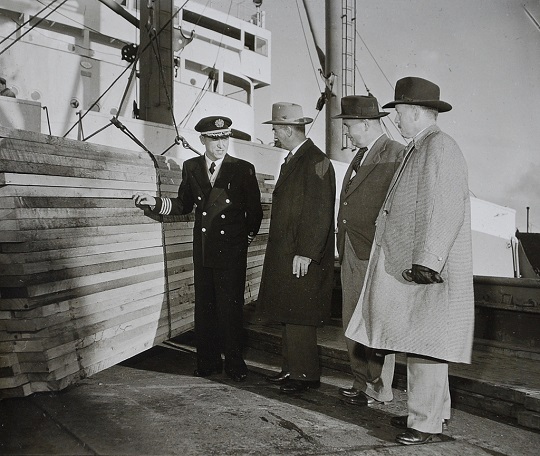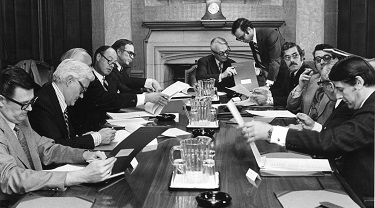The year was 1944. The Second World War was still raging. Most of Europe’s ports had either been smashed into useless tangles or heavily damaged. Meanwhile, back in Canada, the government was preparing to take a leap of faith, planning how to sustain the booming wartime economy as the world navigated its way into peace. Those strategy sessions marked the beginning of Export Development Canada.
Flourishing in terrible times
The war was an unsettling paradox for Canadians: more than 40,000 of our soldiers were killed and yet Canadian industry had become a vigorous, confident triumph. It dazzled even more in contrast with the Great Depression of the 1930s, a grim eternity of food lines and despondence. In the years leading up to the war, unemployment rates soared, topping out at two-thirds in the Prairies, where dust storms nicknamed “black blizzards” choked out crops with dust so thick, it was difficult to see farther than your outstretched hand.
When the match of war was struck in 1939, Parliament put $1.3 billion into creating new factories and plants. Jobs were there for anyone who wanted one. We became Britain’s tightest ally in the North Atlantic and a major source of their armaments and food.
Our trade relationship with Britain was already growing before the war, spurred on inadvertently by the United States. The demand for Canadian exports in the U.S. was way down during the depression and even the people who had money were hoarding it. Uncle Sam also had a spike of protectionist fever in 1930, imposing tariffs that affected all of America’s trading partners. The new conditions were particularly ruthless to Canadian businesses.
Britain was also indulging in a wave of protectionism that favoured imports from the Commonwealth and Canada took full advantage. The value of the Canadian goods arriving in Britain’s ports more than doubled between 1929 and 1938.

Calming trade nerves
Even though our exports thrived during the war, Canadians were still shuffling their feet in 1944, circumspect about what would happen when the bombs stopped dropping. At one point during the fighting, 75% of our exports were munitions. But we knew that those exports were going to come to an abrupt standstill when the war ended. Moreover, the trading boom with Britain couldn’t maintain its momentum: Britain had all but bankrupted itself in the fight against Hitler.
Europe’s purchasing power was also decimated. The continent was a crush of destruction that today is hard to understand. Many cities were wholly undone, existing largely as tumbles of debris. Ruined cities meant ruined government, healthcare facilities, policing and more. Millions were dead or displaced, few had money. Canadians were uneasy that the economic misery experienced by their trading partners would carry across the ocean and Canada would flounder again. Something had to be done.
At one point during the fighting, 75% of our exports were munitions. But we knew that those exports were going to come to an abrupt standstill when the war ended.
Four desks and a plan
To help ease the stress, Prime Minister William Lyon Mackenzie King’s government greenlit many initiatives to promote continued production of Canadian goods.
We were one of them: originally named Export Credits Insurance Corp., EDC was born as small program designed to insure Canadian exporters’ accounts receivable. A room was rented for $50 a month at the Foreign Exchange Control Board headquarters in Ottawa. By 1945, there were four occupied desks and the first insurance policy had been granted to Atlas Steel Ltd., a company based near Niagara Falls.

Having this insurance meant that if a customer abroad didn’t pay for the Canadian goods they received, Canadian companies could claim the lost income. This often meant the difference between staying in business and going bankrupt. The insurance was designed to fortify Canadian businesses, support the economy, and boost the spirits of Canadians, many of whom depended on exporting to put food on the table.
Fast-forward 75 years and modern shipping ports now roar with growth and abundance. Huge vessels lumber up to docks. Towering cranes pluck shipping containers from the strict geometry of cargo ships, placing them onshore as easily as children’s building blocks—but these blocks build a country’s economic muscle.
Though renamed, Export Development Canada’s commitment has never changed: To help Canadian businesses, big and small, grow beyond our borders with confidence. Our work has put more than a trillion dollars into Canada’s GDP. We serve more than 13,000 customers today, covering every Canadian industry and sector in 200 global markets. Our human rights and climate policies put us among the world’s leading progressive export credit agencies.
There have been so many incredible changes in Canada’s role in global trade in the last three-quarters of a century, and we are so proud to have been a part of it. Here’s to the next 75.




